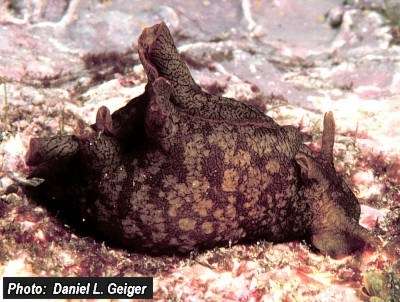
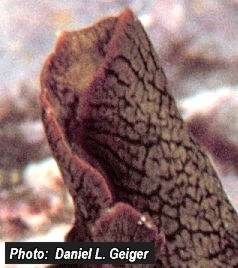
Aplysia depilans
Gmelin, 1791
Order: ANASPIDEA
Superfamily: APLYSIOIDEA
Family: Aplysiidae
DISTRIBUTION
SW British Isles, Atlantic coast of France to Mediterranean, West Africa.
PHOTO
Banyuls sur Mer, Mediterranean coast of France, March 1991, on rock in upper sublittoral. Lower photo - closeup of parapodial lobe showing reticulate veining and pinkish parapodial margin. PHOTO: Daniel Geiger
Grows to about 30cm. Brown to greenish-brown with blotches of white, yellow or grey, often with blackish veining (see lower photo). The parapodial lobes are joined rather high posteriorly and the foot often forms a temporary sucker. Mediterranean animals are reported to swim. Produces both white and purple secretions when disturbed.
Reference:
• Thompson, T.E. & Brown, G.H. (1984) Biology of Opisthobranch Molluscs, Vol 2. Ray Society: London.
Rudman, W.B., 1999 (September 29) Aplysia depilans Gmelin, 1791. [In] Sea Slug Forum. Australian Museum, Sydney. Available from http://www.seaslugforum.net/find/aplydepi
Related messages
Re: Aplysia fasciata and A. punctata from Antibes
November 28, 2007
From: Dominique Horst
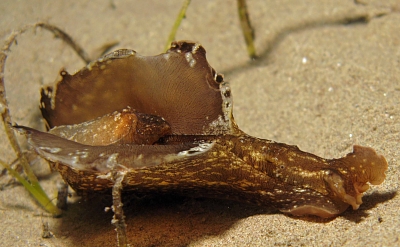
Concerning message #17002:
Hello Bill,
Following your last answer and as regards the opening of the parapodia, this should be Aplysia fasciata. But there is no red border and many white spots ?
Could you confirm the identification as A.fasciata?
Locality: Antibes Cape, 5m, France, Mediterranean sea, 11 October 2007. Length: 5 cm. Photographer: Dominique Horst (photos 1-2) & Eric Poisson (photo 3).
Many thanks and kind regards,
Dom.
dominique.horst@wanadoo.fr
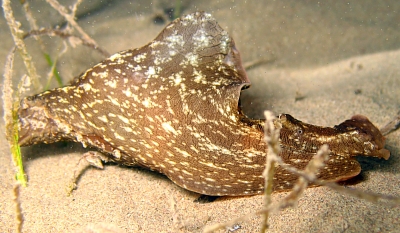
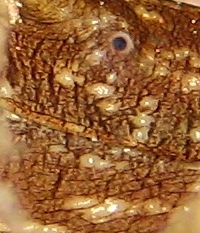

Dear Dom,
I don't want to set myself up as an expert on Eurpean sea hares, as photos can be misleading, but I suspect this is A. depilans rather than A. fasciata. Both can have white blotches on their body but A. depilans also has the dark lines formed in a reticluate pattern.
More impotrtantly, if you look at the photo alonmgside you can see that the two parapodia form quite a high wall in the posterior midline
Best wishes,
Bill Rudman
Massive death of Aplysia depilans in Italy
June 24, 2005
From: Matteo Tassi
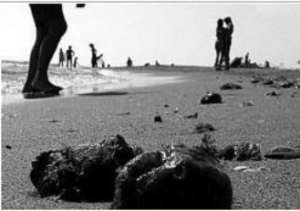
Dear Bill,
I live in Ostia, Rome, Italy. In the last two weeks we have seen thousands of Aplysia depilans dying on our beaches. I am trying to understand if there has been any occurence like this somewhere else in order to save and protect these fine animals.
Locality: Ostia Lido, Rome, Italy. Mediterranean. Length: 20-40 cm. 22 June 2005. near rivermouth.
Matteo Tassi
matteo@tecnomar.net
matteo@ilsottomarino.org
Tassi, M., 2005 (Jun 24) Massive death of Aplysia depilans in Italy. [Message in] Sea Slug Forum. Australian Museum, Sydney. Available from http://www.seaslugforum.net/find/14121Dear Matteo,
These mass swarming, and mass mortality events seem to be natural part of the life of Sea Hares. I have recently posted messages [see #14080] concerning mass swarmings of the small sea hare Stylocheilus striatus in both Hawaii and the Caribbean. Have a look at the Mass mortality Fact Sheet for background information on this worldwide phenomenon and links to many other examples described on the Forum.
Best wishes,
Bill Rudman
Aplysia punctata? from Sicily
October 2, 2003
From: Sara
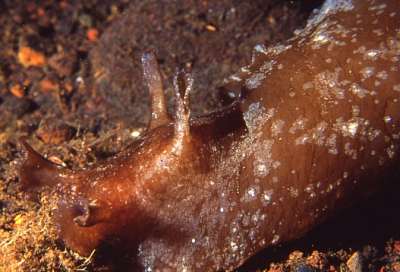
Hello,
My husband and I found this Aplysia in August in Sicily, at a depth of about 15 m during a night dive. Before seeing this Forum I thought it was Aplysia depilans, but now I think it is A. punctata. Could you please confirm?
Sara
sara.valla@unipr.it
Sara, 2003 (Oct 2) Aplysia punctata? from Sicily. [Message in] Sea Slug Forum. Australian Museum, Sydney. Available from http://www.seaslugforum.net/find/10997Dear Sara,
Sea Hares can at times be quite difficult to identify and I am afraid a photo of just the front half doesn't give me enough information to be sure. Both A. depilans and A. punctata have the parapodia joined quite high at the back of the animal while in A. fasciata the parapodia are not really joined posteriorly. Also in A. punctata the shell is visible through a large opening or foramen in the mantle, while in A. depilans there is a very small pore. Another difference is that in A. depilans the posterior end of the foot often forms a broad rounded temporary sucker, as the animal crawls along, while in the other species it doesn't. You may be able to see some of these details in other photos, or you may remember from the living animal
Best wishes
Bill Rudman
Aplysia depilans (?) from Senegal
September 25, 2003
From: Marina Poddubetskaia
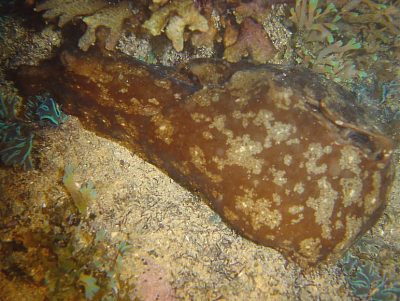
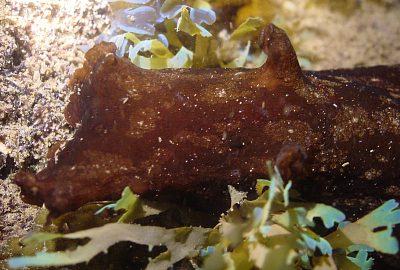
Dear Bill,
Here is another Sea-Hare from Senegal. I don't think it is the pale colour form of Aplysia fasciata because there isn't any red border either to parapodia or oral tentacles. Could it be Aplysia depilans? This animal was found during night dive.
Date: June 02, 2003
Location: Dakar, Senegal, Eastern Atlantic
Site: Terou baye Sogui
Depth: 1m
Size: 17-18cm
Photos: Marina Poddubetskaia - Nembro website
Cordially,
Marina.
nembro@nembro.info
Poddubetskaia, M., 2003 (Sep 25) Aplysia depilans (?) from Senegal. [Message in] Sea Slug Forum. Australian Museum, Sydney. Available from http://www.seaslugforum.net/find/10333Dear Marina,
I think you are correct in identifying this as Aplysia depilans. In your upper photo it seems as though the parapodia are joined quite high posteriorly.
Best wishes
Bill Rudman
Aplysia depilans from Tunisia
July 28, 2003
From: J. Ben Souissi and A. Eters
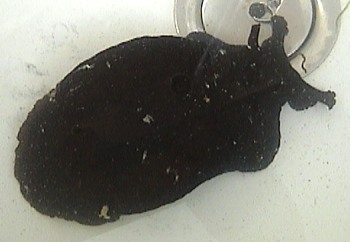
Dear Bill,
This Aplysia is another of the opisthobranchs we found in a coastal lagoon, "Lac de Tunis" [south section] in Tunis, Tunisia, North Africa. Depth: 0 to 1m some time between January and March, 2003.
Can you identify it please.
Thanks,
Jamila Ben Souissi and Anis Eters
mal_de_toi@cybercartes.com
Ben Souissi, J. & Eters, A., 2003 (Jul 28) Aplysia depilans from Tunisia. [Message in] Sea Slug Forum. Australian Museum, Sydney. Available from http://www.seaslugforum.net/find/9890Dear Jamila & Anis,
It is not easy to identify the species from this angle but the broad sucker-like foot make me think it is most probably Aplysia depilans
Best wishes,
Bill Rudman
Aplysia depilans from Portugal
June 28, 2002
From: João Pedro Silva
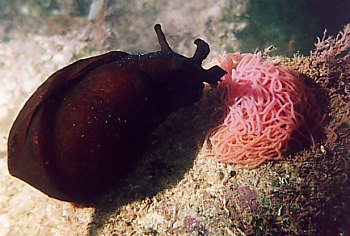
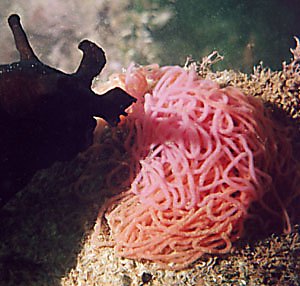
Dear Bill,
During the past two weeks I was on vacation at Baleal [west coast, Portugal] and I took some more pictures. If you haven't got tired of Aplysia sp. photos, here is one of an Aplysia depilans with egg mass taken at 3m depth under a large rock. In my website I decided to separate the photos by themes so now I have a page dedicated to sea hares ("vinagreiras"): http://jpsub0.tripod.com/vinagreiras.html
All the best,
João Pedro
joao.tojal.silva@novabase.pt
Silva, J.P., 2002 (Jun 28) Aplysia depilans from Portugal. [Message in] Sea Slug Forum. Australian Museum, Sydney. Available from http://www.seaslugforum.net/find/7358Thanks João Pedro,
Photos showing egg masses etc are always welcome
Best wishes,
Bill Rudman
Aplysia depilans from Portugal
April 23, 2002
From: João Tojal Silva
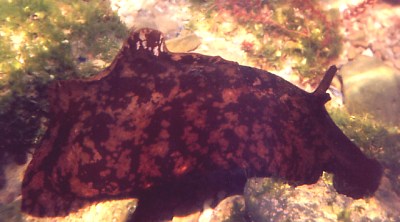
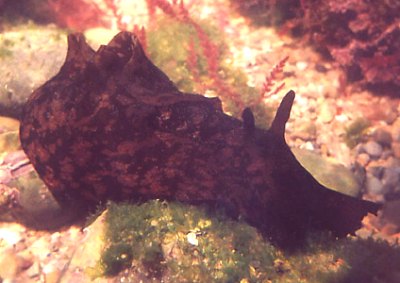
Dear Bill,
In early April I went for a walk during the low tide in Baleal (Portugal) and found dozens of Aplysia punctata, some mating, and two fairly large Aplysia fasciata in the small pools in the rock. A few days later I returned with my camera and although I didn't find any A. fasciata, I found a nice A. depilans.
The photos were taken in rock pools during the low tide, no more than 50cm deep. The A. depilans was about 15cm long. I have sent the photos of Aplysia punctata separately.
Hope you like them!
All the best,
João Pedro
joao.tojal.silva@NOVABASE.PT
Silva, J., 2002 (Apr 23) Aplysia depilans from Portugal. [Message in] Sea Slug Forum. Australian Museum, Sydney. Available from http://www.seaslugforum.net/find/6791Dear João,
Thanks for thinking about us. Although Sea Hares are common, their relatively large size and shallow water habitat make them a nuisance for most photographers of nudibranchs. So good photos of them are always welcome.
Best wishes,
Bill Rudman
Aplysia from Portugal
November 28, 2001
From: João Pedro Silva
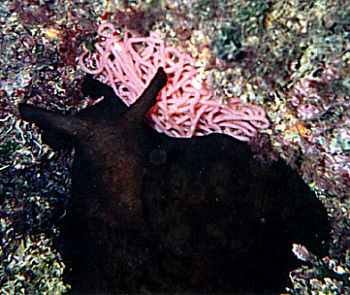
Hello,
I've just found your website and thought you might appreciate this photo, although I understand it's not even near "good quality". It's an Aplysia depilans laying its eggs [UPPER RIGHT]. It was taken on the evening of the 3rd of November of 2001 in Baleal, Portugal, which is a peninsula situated aproximately 80km north of Lisbon (see map). It was taken at aproximately 1m depth with a Bonica Seaking Snapper with a 1:6 macro and using the built in flash. The bottom in that area is covered with small rocks (between 0.125m3 and 1m3). The area is situated on the western edge of the peninsula and is very much exposed to waves coming from northwest.
I'm also including a photo [LOWER RIGHT]with a detail of an Aplysia fasciata, another common species in this area. That one was taken in the eastern margin of the peninsula, an area with sandy bottom punctuated with some small rocks. Apart from these two species, Aplysia puctata is also found here, although not as frequently as the others. Just one final note, Aplysia are known in Portuguese as "vinagreira" (pl. "vinagreiras"). This may be a reference to the purple ink ("vinagre" means vinegar in Portuguese) as vinegar in some areas is predominantly produced from red wine.
Well, hope you find this useful. Sorry for my English, it's a bit rusty.
Best regards,
Joao Pedro Silva
jpsilva@infordesporto.pt

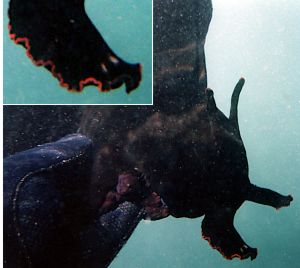
Dear João,
Thanks for the interesting information on Sea Hares in your part of the world. It was interesting to hear that in Portugal they are called "vinagreira". Last year I was told by a French friend that in southern France they are called 'Pisse vinaigrette' - again in reference to their ink.
Best wishes,
Bill Rudman
Re: Aplysia depilans
October 3, 1999
From: Andy Horton
Hello Bill,
The only Aplysia found on the shores of mainland Britain is Aplysia punctata. The occurrence of A. depilans, even a dead one, (see report) is a notable discovery.
Cheers
Andy Horton.
bmlss@compuserve.com
Horton, A., 1999 (Oct 3) Re: Aplysia depilans. [Message in] Sea Slug Forum. Australian Museum, Sydney. Available from http://www.seaslugforum.net/find/1394Thanks Andy,
I wasn't trying to belittle your record, I just wanted to clarify that the photo was of a dead, somewhat swollen, animal, so that Sea Hare 'novices' wouldn't mistakenly think that this was what Aplysia depilans looked like alive.
Cheers,
Bill Rudman.
Aplysia depilans in Guernsey
October 1, 1999
From: Andy Horton
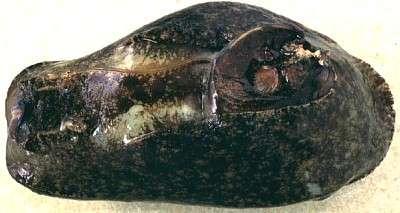
Dear Bill,
A Sea Hare, Aplysia depilans, floated into St. Peter Port harbour, Guernsey, British Channel Islands on September 21, this year. It weighed 242 grams and was 147 mm long and 80 mm wide. The parapodia (conspicuous lateral lobes) of Aplysia depilans are fused posteriorly.
This is the first A. depilans I have seen although in June and July of this year I saw at least one hundred of the commoner A. punctata either spawning on seaweed or washed up on Guernsey beaches. [Reported by: Richard Lord from Guernsey, fishinfo@guernsey.net]
Andy Horton
bmlss@compuserve.com
Horton, A., 1999 (Oct 1) Aplysia depilans in Guernsey. [Message in] Sea Slug Forum. Australian Museum, Sydney. Available from http://www.seaslugforum.net/find/1380Thanks Andy,
By 'floating in' do you mean it was dead? The photo looks a bit post mortem. Reminds me of taking a new technician on a collecting trip some years ago and after two days without him finding anything, he was feeling as though he was letting down the team effort. His first find, a day later, was a very large but dead Aplysia extraordinaria, which, to encourage him, we all said was a good find. However after 3 hours driving in the hot sun with the dead Aplysia (and an hour still to drive), even he agreed it had to go, and with mixed feelings he was given the job of throwing it into the nearest paddock, much to the puzzlement of a herd of cows.
Bill Rudman.
